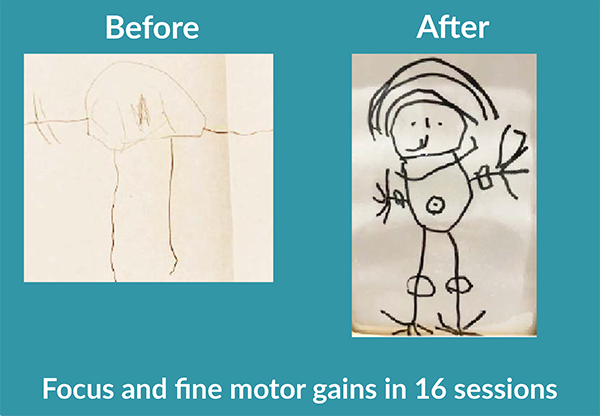Help for attention, fine motor skills, and emotional regulation.
Constant fidgeting, attention issues, and fine-motor skills were some of the challenges this 5-year-old boy was facing. Find out how his OT introduced rhythmic movements and primitive reflex integration and, over the course of 16 sessions, saw significant improvements with all of these issues.
Submitted by Ingrid King, MScOT, BOT

| Before | After |
|---|---|
| Could not maintain focus or sit for the class mat times; fidgeted | Can now sit for longer periods |
| Tended to resist adult directions | Progressing significantly in following adult directions |
| Primarily engages in parallel play | Plays cooperatively with other children more often |
| When playing, would become upset, throwing or knocking things over | No longer knocking down or throwing things at school |
| Unable to catch a large ball with both hands | Can catch a large and smaller ball with two hands |
| Swapped between right and left hands | Using his right hand more consistently |
| Used a fisted grasp when coloring | Intermittently uses a tripod grasp |
Matt is a 5 year old boy who was referred to me for occupational therapy. Shortly after I began working with him, he was diagnosed with ADHD.
Matt needed to move or fidget constantly. He could not sit calmly while having a story read to him, and he seldom sat down to watch TV. He could not balance on one leg for five seconds or catch a large ball with both hands. Matt appeared to have low muscle tone with a slouched seated posture. He used a fisted grasp to color in with, and would swap from right to left hands. Matt tended to avoid fine motor activities and his drawing of a person was very simplistic (see image).
At Kindy, he played happy outside with sand and water but could not maintain focus or sit for the class mat times. He struggled to join in play with other children, and at times, became very upset, throwing or knocking things over. Matt had a tendency to resist adult directions but responded well to instant rewards. He was affectionate and appeared to crave adult attention. He struggled with transitions and sometimes ordered toys at Kindy. At night, his mum struggled for up to an hour to get him to settle down to go to sleep.
My first six half-hour sessions with him were once a week at Kindy. Initially, I was unable to assess his infant reflexes as he was not keen to comply or remain still enough. I suspected from these issues that his Tonic Labyrinthine Reflex was unintegrated, along with others including Fear Paralysis and Moro Reflexes, the Asymmetrical and Symmetrical Tonic Neck Reflexes, and possibly the hand and feet reflexes (as he was sensitive to touch and very ticklish on his feet).
So I began with playful developmental movements and games [from the Brain and Sensory Foundations course].
Over two summer months we stopped therapy but his family played a lot with him in their swimming pool, and on their trampoline which he loved.
Our next eight sessions were fortnightly for an hour at home. Each session he participated in the rhythmic movements from the Brain and Sensory Foundations course. His mum began to do these movements with him a couple of times a week too. He responded to the passive rhythmic movements by rubbing his eyes and looking sleepy, which I took as a sign of his nervous system being able to calm down. We continued with developmental movements and games adding in belly crawling, rolling, and hitting a balloon up in the air while balancing on a wobble cushion in high kneeling.
On our 14th therapy session, I was able to instruct him to stand still to assess his Tonic Labyrinthine Reflex which was still present with trunk rigidity and swaying when his eyes were closed. However, a number of issues had changed significantly including:
- Matt now able to sit at mat times for longer periods without disrupting the others
- He sat still long enough to draw a detailed picture of a person (see image)
- Matt is progressing significantly in following adult directions
- He is playing cooperatively with other children as opposed to more parallel play
- There have been no recent incidents of knocking down or throwing things at Kindy
- He can catch a large and smaller ball with two hands
- Matt is using his right hand more consistently and swapping to the left much less, at times he uses a tripod grasp.
Due to this success, we will be continuing as before but increasing the frequency of the rhythmic movements at home. I will assess the other reflexes, and possibly introduce some isometrics [from the Brain and Sensory Foundations course] in a playful manner. We hope to see his ADHD symptoms continue to decrease to such a level that medication will not be needed.
The time frames were as follows:
- 1.5 months of developmental play and then a 2 month family vacation with time outdoors in the pool and on the trampoline.
- Then 4 months of rhythmic movements and TRL work with no home program as family was too busy
Total was 16 OT sessions but good progress by 14th OT session (so overall it was 7.5 month time frame because of the 2 months off).
Without this [Brain and Sensory Foundations] approach, you would never see this type of progress after 16 sessions of OT especially given that there was a 2 month break and the OT sessions were not every week (and the family did very little).
[edited for length and clarity]

